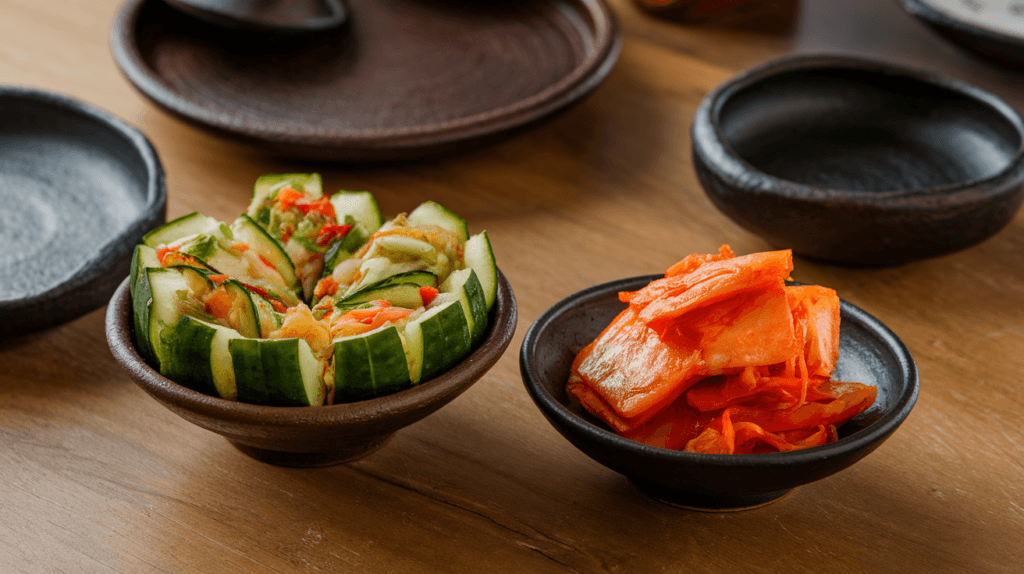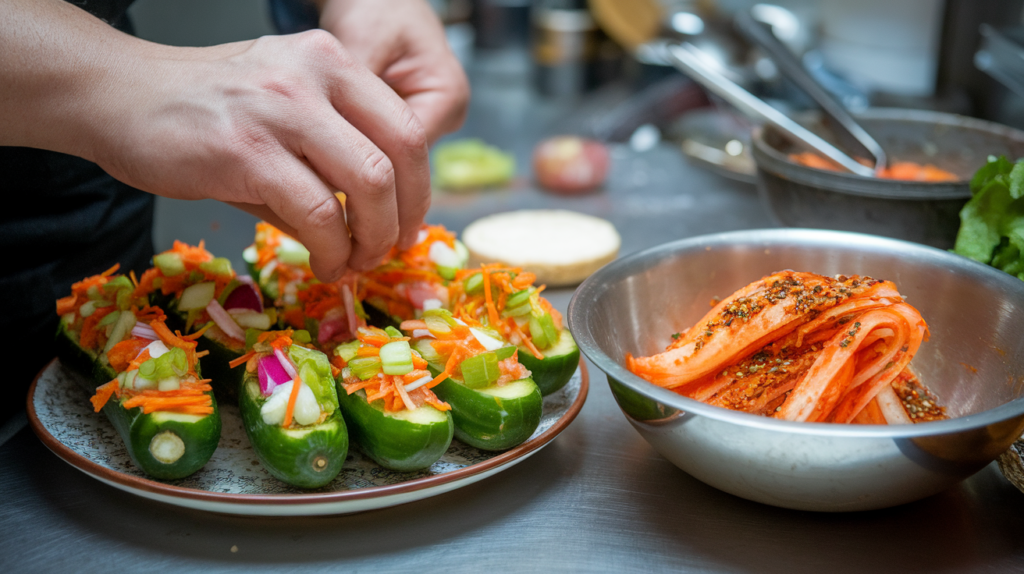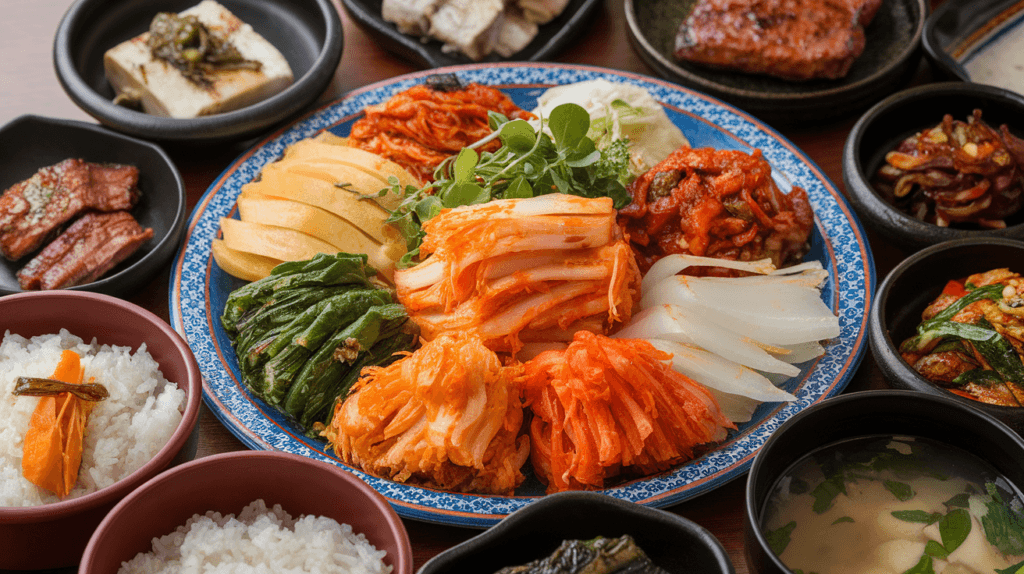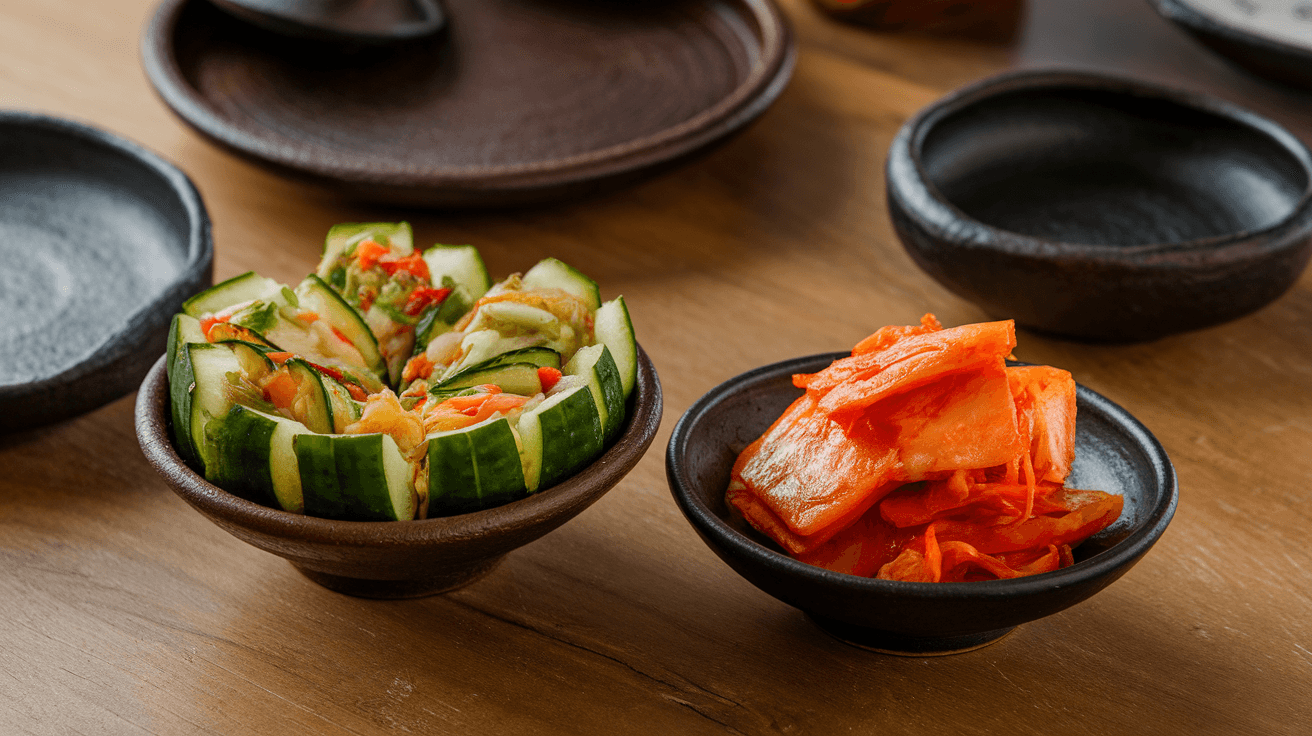Introduction
When it comes to Korean cuisine, kimchi is undoubtedly one of the most iconic dishes. Within the realm of kimchi, variations abound, offering different textures, flavors, and preparation methods. Two such variations, Oi Sobagi and Oi Kimchi, stand out for their use of cucumbers as the primary ingredient. While they may appear similar at first glance, these two dishes are distinct in preparation, flavor, and cultural significance. This article will delve into the differences between Oi Sobagi and Oi Kimchi, exploring their origins, ingredients, health benefits, and more.

Whether you’re a Korean food enthusiast or a curious newcomer, understanding the nuances of these cucumber-based delights can enrich your culinary knowledge. Let’s dive in and explore what makes Oi Sobagi and Oi Kimchi unique!
What is Oi Sobagi?
Oi Sobagi, also known as cucumber kimchi, is a refreshing and mildly spicy variation of traditional Korean kimchi. It uses fresh cucumbers as the main ingredient, stuffed with a flavorful mixture of spices and vegetables. Unlike other types of kimchi that require long fermentation, people often enjoy Oi Sobagi fresh. Its crisp and crunchy texture complements a variety of meals.
Origins of Oi Sobagi
The history of Oi Sobagi dates back to the evolution of kimchi in Korea, where seasonal vegetables were preserved to ensure availability throughout the year. Oi Sobagi became particularly popular during the warmer months when fresh cucumbers were abundant. This dish is deeply rooted in Korean culinary traditions and is often served as a side dish (banchan) during family meals and festive occasions.
Flavor Profile of Oi Sobagi
The flavor profile of Oi Sobagi is a balance of tangy, spicy, and slightly sweet notes. The cucumbers offer a refreshing crunch, while the stuffing mixture—typically made with gochugaru (Korean red pepper flakes), garlic, ginger, and scallions—adds a punch of flavor. Oi Sobagi is lighter and less pungent compared to other types of kimchi, making it an ideal choice for those new to fermented foods or looking for a milder alternative.
This dish pairs exceptionally well with rice, grilled meats, or even as a standalone snack, thanks to its vibrant flavors and satisfying texture.
What is Oi Kimchi?
Oi Kimchi, another cucumber-based variation of traditional kimchi, delivers robust flavors and a more pronounced fermentation process compared to Oi Sobagi. While it shares similarities with Oi Sobagi in its use of cucumbers, cooks generally prepare Oi Kimchi with a focus on longer fermentation, which creates a tangier and deeper flavor profile. It is a versatile dish, enjoyed both as a side dish and as an ingredient in other Korean recipes.
Origins of Oi Kimchi
Oi Kimchi has its roots in Korea’s long-standing tradition of fermenting vegetables to preserve their nutrients and flavors. Historically, this method of preservation allowed families to enjoy fresh-tasting vegetables even during harsh winters. Oi Kimchi has evolved over time, with regional variations influencing its preparation and flavor, making it a beloved staple across Korea.
Flavor Profile of Oi Kimchi
Unlike Oi Sobagi, Oi Kimchi tends to have a more intense and sour flavor due to the extended fermentation process. The cucumbers absorb the marinade, becoming slightly softer while still retaining some crunch. The seasoning, often richer and spicier, includes ingredients like gochugaru, fish sauce, and fermented shrimp, which add layers of umami to the dish.
Oi Kimchi is highly versatile and pairs wonderfully with Korean classics such as bibimbap, stews, and grilled proteins. Its complex flavor profile makes it a favorite among those who enjoy bolder, fermented foods.
Key Differences Between Oi Sobagi and Oi Kimchi
While both Oi Sobagi and Oi Kimchi are cucumber-based Korean dishes, they differ significantly in terms of ingredients, preparation, fermentation, and overall flavor. Understanding these differences can help you choose the right dish to suit your taste and culinary preferences.
Fermentation Process

One of the most notable differences between Oi Sobagi and Oi Kimchi lies in their fermentation process. Oi Sobagi is often consumed fresh or after a very short fermentation period, usually within a day or two. This quick preparation results in a crisp, bright, and mildly tangy dish that retains the cucumber’s natural crunch.
In contrast, Oi Kimchi is prepared with a focus on longer fermentation, typically ranging from a few days to a week. This extended process allows the cucumbers to absorb the marinade fully and develop a more intense, sour, and umami-rich flavor.
Spice Levels and Seasoning
Oi Sobagi generally has a milder spice level compared to Oi Kimchi. The stuffing for Oi Sobagi often emphasizes freshness, with scallions, garlic, and a lighter use of gochugaru. This makes it appealing to those who prefer a less spicy experience.
Oi Kimchi, on the other hand, typically incorporates a more robust seasoning blend, including heavier amounts of gochugaru, fermented shrimp, and fish sauce. These ingredients contribute to its bold and spicy flavor, making it a favorite among fans of traditional kimchi.
Texture and Appearance
Oi Sobagi is characterized by its distinct stuffed appearance, where cucumbers are sliced and filled with a mixture of vegetables and spices. This preparation method preserves the cucumber’s firm and crunchy texture, offering a delightful bite.
Oi Kimchi, however, is less structured in appearance. The cucumbers are often sliced or cut into chunks and mixed thoroughly with the marinade. Due to the fermentation process, the texture becomes softer and slightly more pliable while still maintaining some crunch.
Serving and Culinary Uses
Oi Sobagi is usually served as a refreshing side dish during summer, prized for its lightness and crispness. It pairs exceptionally well with grilled meats or rice-based dishes.
Oi Kimchi, with its bold and tangy flavors, offers versatility and enhances a variety of dishes. Cooks frequently use it as an ingredient in stews, soups, and stir-fries, adding depth and complexity to the overall flavor.
Health Benefits of Oi Sobagi and Oi Kimchi

Both Oi Sobagi and Oi Kimchi offer a wealth of health benefits, thanks to their nutrient-rich ingredients and fermentation processes. While their nutritional profiles vary slightly, both dishes contribute positively to overall health and well-being.
Probiotic Content
Fermented foods like Oi Kimchi are renowned for their high probiotic content. The fermentation process introduces beneficial bacteria, such as Lactobacillus, which promote gut health. Probiotics support digestion, enhance nutrient absorption, and strengthen the immune system. Oi Sobagi, while consumed fresh or minimally fermented, still provides some probiotic benefits if left to ferment briefly.
By including either Oi Sobagi or Oi Kimchi in your diet, you can help maintain a healthy gut microbiome, which is essential for overall health.
Vitamin and Mineral Contributions
Both dishes are rich in vitamins and minerals, largely derived from their fresh ingredients. Cucumbers are an excellent source of hydration and contain essential nutrients like vitamin K, potassium, and magnesium. The additional vegetables used in the recipes, such as scallions and garlic, contribute antioxidants, vitamin C, and anti-inflammatory compounds.
Oi Kimchi, with its richer seasoning, often includes ingredients like fermented shrimp or fish sauce, which add trace amounts of iodine and other beneficial nutrients.
Low in Calories, High in Fiber
Oi Sobagi and Oi Kimchi are naturally low in calories, making them excellent options for those watching their calorie intake. They are also high in dietary fiber, which aids digestion, promotes satiety, and helps regulate blood sugar levels. Incorporating these dishes into a balanced diet can support weight management and overall health.
Unique Benefits of Oi Sobagi
Oi Sobagi stands out for its refreshing and hydrating qualities, making it an ideal choice during hot weather. Its light seasoning ensures that it remains gentle on the stomach, making it suitable for individuals sensitive to heavily spiced or fermented foods.
Unique Benefits of Oi Kimchi
Oi Kimchi, with its extended fermentation process, provides stronger probiotic effects and a more robust nutritional profile. Its bold flavors also make it a versatile ingredient that can elevate the taste of various dishes while contributing additional health benefits.
How to Make Oi Sobagi at Home
Making Oi Sobagi at home is a straightforward process that allows you to enjoy this refreshing cucumber kimchi anytime. The recipe requires fresh ingredients and a few simple steps, making it an excellent option for beginners exploring Korean cuisine.
Ingredients for Oi Sobagi
- 6 small cucumbers (preferably Korean or Persian cucumbers)
- 2 tablespoons of salt
- 1 cup of julienned carrots
- 1 cup of julienned Korean radish
- 4 scallions, chopped
- 3 cloves of garlic, minced
- 1 teaspoon of grated ginger
- 2 tablespoons of gochugaru (Korean red pepper flakes)
- 1 tablespoon of fish sauce (optional for added depth)
- 1 teaspoon of sugar
Step-by-Step Instructions
- Prepare the Cucumbers: Wash the cucumbers thoroughly and slice each one lengthwise into quarters, leaving the ends intact to form a “pocket” for the stuffing. Sprinkle the cucumbers with salt and let them sit for 20-30 minutes. This step helps to draw out excess moisture and enhance their crispness.
- Rinse and Drain: After salting, rinse the cucumbers under cold water to remove excess salt. Drain them well and set aside.
- Make the Stuffing Mixture: In a bowl, combine the julienned carrots, radish, scallions, garlic, ginger, gochugaru, fish sauce (if using), and sugar. Mix well until the vegetables are evenly coated with the seasoning.
- Stuff the Cucumbers: Gently fill the “pockets” of each cucumber with the stuffing mixture. Be generous with the filling to ensure a flavorful bite in every piece.
- Store and Chill: Place the stuffed cucumbers in an airtight container. For immediate consumption, refrigerate for 1-2 hours to allow the flavors to meld. If you prefer a slightly fermented taste, let the cucumbers sit at room temperature for 6-12 hours before refrigerating.
- Serve: Serve your Oi Sobagi as a side dish alongside rice, grilled meats, or your favorite Korean dishes. Enjoy the refreshing crunch and vibrant flavors!
Homemade Oi Sobagi can be stored in the refrigerator for up to 1 week, although it is best enjoyed fresh to preserve its crisp texture.
How to Make Oi Kimchi at Home
Preparing Oi Kimchi at home is a rewarding process that yields a tangy, flavorful dish perfect for kimchi lovers. With a slightly longer fermentation time compared to Oi Sobagi, this recipe brings out deeper flavors and more complex textures.
Ingredients for Oi Kimchi
- 6 small cucumbers (Korean or Persian cucumbers preferred)
- 2 tablespoons of salt
- 1 tablespoon of sugar
- 1 cup of julienned Korean radish
- 4 scallions, chopped
- 3 cloves of garlic, minced
- 1 teaspoon of grated ginger
- 2 tablespoons of gochugaru (Korean red pepper flakes)
- 1 tablespoon of fish sauce
- 1 tablespoon of salted fermented shrimp (saeujeot, optional for umami)
Step-by-Step Instructions
- Salt the Cucumbers: Wash the cucumbers and cut them into chunks or slices, depending on your preference. Toss them in a large bowl with salt and sugar, ensuring even coating. Let the cucumbers sit for 20-30 minutes to draw out excess water.
- Rinse and Drain: Rinse the cucumbers thoroughly under cold water to remove the excess salt. Drain well and set aside.
- Prepare the Seasoning Paste: In a bowl, mix the gochugaru, garlic, ginger, fish sauce, and fermented shrimp (if using). Add the julienned radish and scallions to the bowl and mix until the vegetables are evenly coated with the seasoning paste.
- Combine with Cucumbers: Add the drained cucumbers to the seasoning mixture and toss gently to ensure every piece is thoroughly coated with the flavorful paste.
- Pack into a Container: Transfer the seasoned cucumbers to an airtight container or jar. Press them down firmly to minimize air pockets, which can interfere with fermentation.
- Ferment: Leave the container at room temperature for 12-24 hours to kickstart the fermentation process. Once it begins to bubble and develop a tangy aroma, transfer it to the refrigerator to slow the fermentation.
- Serve: After 1-2 days of refrigeration, your Oi Kimchi will be ready to enjoy. Serve it as a side dish or incorporate it into other recipes like stews or stir-fries for a burst of flavor.
Homemade Oi Kimchi can be stored in the refrigerator for 2-3 weeks, with the flavor intensifying as it continues to ferment.
Frequently Asked Questions (FAQs)
Can Oi Sobagi be stored for a long time?
People enjoy Oi Sobagi best when it is fresh or consumed within a week of preparation. While you can store it in the refrigerator for up to a week, its texture may soften over time, and the flavors might intensify slightly. To retain its signature crispness, consume Oi Sobagi within a few days.
Is Oi Kimchi always spicy?
No, Oi Kimchi can be adjusted to suit individual spice preferences. While traditional recipes include gochugaru (Korean red pepper flakes) for heat, you can reduce or omit this ingredient for a milder version. Alternatively, you can experiment with sweeter or tangier seasonings to customize the flavor.
What type of cucumbers are best for these recipes?
Cooks prefer Korean or Persian cucumbers for both Oi Sobagi and Oi Kimchi because of their smaller size, thin skin, and crisp texture. English cucumbers can also work, but experts recommend avoiding large, seedy cucumbers since they do not provide the same crunch or absorb flavors as effectively.
Can Oi Sobagi or Oi Kimchi be made vegan?
Yes, both dishes can be made vegan by omitting ingredients like fish sauce and fermented shrimp. Instead, you can use soy sauce or a vegan fish sauce alternative to achieve a similar depth of flavor. The remaining ingredients are plant-based and suitable for vegan diets.
Do Oi Sobagi and Oi Kimchi have the same health benefits?
Both dishes offer excellent health benefits, including being low in calories and high in fiber, vitamins, and antioxidants. However, Oi Kimchi typically has a higher probiotic content due to its extended fermentation process, which may provide additional gut health benefits compared to the fresher Oi Sobagi.
What are some dishes that pair well with Oi Sobagi and Oi Kimchi?
Oi Sobagi pairs well with grilled meats, rice dishes, and light soups, thanks to its refreshing and mild flavors. Oi Kimchi, with its bold and tangy profile, complements heartier dishes such as stews, bibimbap, and fried rice. Both are versatile enough to be enjoyed on their own or as part of a larger Korean meal spread.
Conclusion
In the world of Korean cuisine, Oi Sobagi and Oi Kimchi stand out as delicious and versatile cucumber-based dishes, each offering unique flavors and textures. While Oi Sobagi is known for its fresh, crisp taste and minimal fermentation, Oi Kimchi brings a bolder, tangier profile due to its extended fermentation process. Both dishes are rich in nutrients, easy to prepare, and perfect additions to a balanced diet.
Whether you’re drawn to the refreshing crunch of Oi Sobagi or the complex flavors of Oi Kimchi, both dishes showcase the incredible diversity of Korean kimchi traditions. By understanding their differences in ingredients, preparation, and health benefits, you can choose the one that best suits your taste or explore both to enjoy their distinct characteristics.
So, why not try making Oi Sobagi and Oi Kimchi at home? With simple recipes and easily accessible ingredients, you can bring a taste of Korea to your table and savor the delightful flavors of these iconic dishes.
Happy cooking and enjoy your culinary journey into the vibrant world of Korean kimchi!

